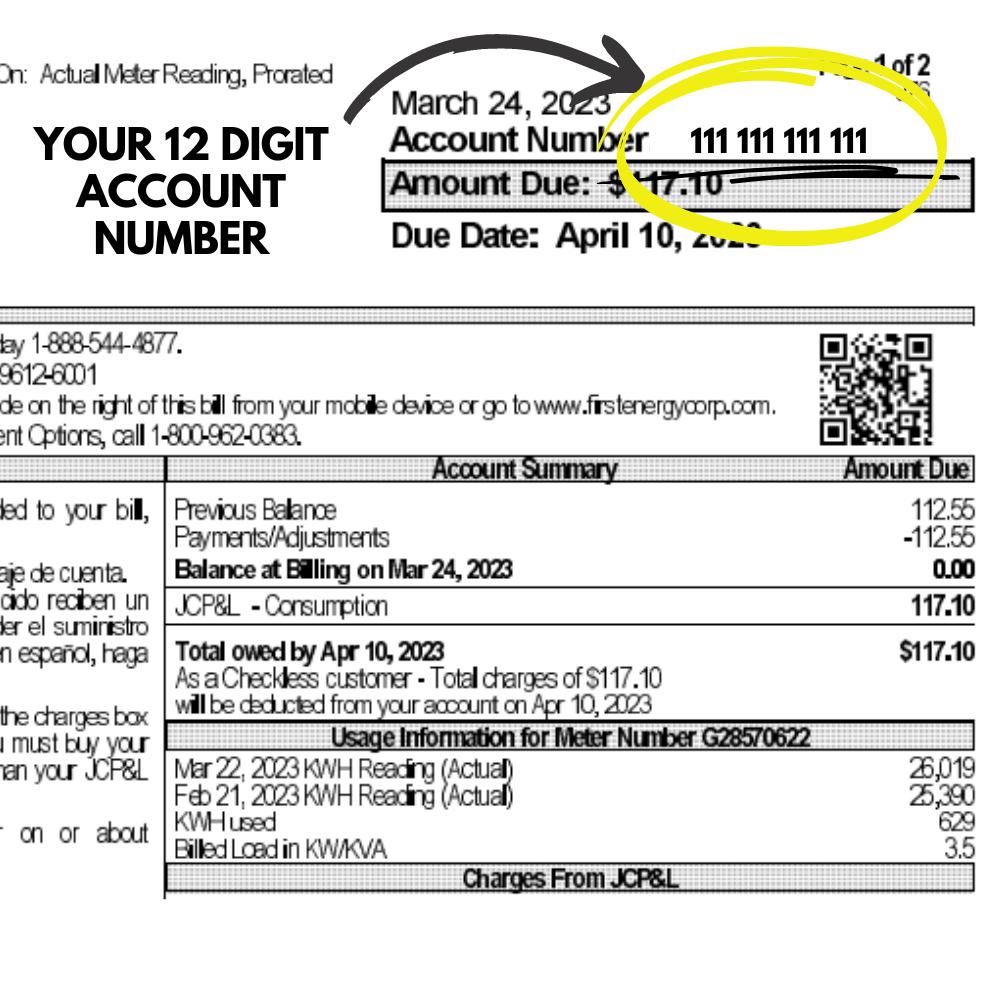Understanding Your JCP&L Bill
Your JCP&L bill is more than just a statement of how much you owe—it’s a detailed report of your energy consumption, giving you insights that can help you manage your household's energy use.
Finding Your JCP&L Account Number
Your JCP&L account number is important for managing your services and making payments. Here’s how you can easily locate it:
On Your Paper Bill
Your account number is located at the top of your bill, making it easy to reference when managing your account or making payments.
Online Account Management
If you’ve registered for online account management with JCP&L, you can log in to your account dashboard to find your account number. It will be displayed on the main page or within the account settings.
JCP&L Mobile App
For customers using the JCP&L mobile app, your account number can be found in the app’s account overview section. This makes it easy to access your account information on the go.

Key Sections of Your JCP&L Bill
Account Information
This section includes your unique JCP&L account number, the billing period, and your payment due date. This information is key for tracking your payments and managing your account.
Energy Usage
JCP&L reads your meter each billing cycle to record your energy consumption. Your bill will display your electricity usage for the billing period, which helps you monitor your consumption trends over time. This can be useful for identifying spikes in usage or finding opportunities to reduce consumption.
Charges Breakdown
The bill provides a clear breakdown of all the charges associated with your energy usage. JCP&L separates these costs into supply, delivery, taxes, and any additional fees, so you can see exactly what you're paying for.
Payment Options
JCP&L offers multiple ways to pay your bill. You can set up automatic payments from your bank account, credit card, or debit card, or you can pay online, by phone, or by mail. You can manage your payment preferences online through the JCP&L customer portal.
The Difference Between JCP&L Supply and Delivery Charges
A key part of understanding your JCP&L bill is knowing the difference between supply and delivery charges. Both of these charges represent different parts of your energy service.
Supply Charges
Supply charges are the costs associated with generating or purchasing the electricity you use. JCP&L does not generate its own electricity but purchases it from energy suppliers. In a deregulated market like New Jersey’s, you have the option to choose a third-party Energy Service Company (ESCO) for your energy supply. While JCP&L still delivers the energy to your home, an ESCO may offer competitive rates for the electricity supply portion of your bill.
Delivery Charges
Delivery charges cover the costs of delivering electricity to your home, including maintaining the infrastructure, such as power lines, transformers, and substations. Delivery fees are regulated by state authorities, ensuring that JCP&L has the resources to maintain a reliable distribution network.
Comprehensive JCP&L Charges Overview
Here’s a breakdown of the various charges you might see on your JCP&L bill:
- Supply Charges: The cost of generating or purchasing the electricity that powers your home.
- Delivery Charges: The costs of delivering electricity from the supplier to your home, including infrastructure maintenance.
- Customer Charges: A fixed monthly fee for maintaining your account and supporting customer service operations.
- Taxes and Fees: State and local taxes that are calculated based on your energy usage and your location.
- Other Charges: These can include late payment fees, service charges for special requests, or costs associated with upgrading equipment, like your meter.
Compare JCP&L Supply Rates
In New Jersey’s deregulated energy market, JCP&L handles delivery, but you can choose who supplies your electricity. Comparing JCP&L’s supply rate to third-party Energy Service Companies (ESCOs) can help you:
- See if your current JCP&L supply rate is higher than competitive market offers.
- Understand how fixed-rate plans compare to variable utility pricing.
- Estimate potential monthly and annual savings without changing your utility.
Use the rate comparison tool below to review current JCP&L supply options and alternative supply offers for your home based on your usage and service address.
Energy-Saving Strategies to Lower Your JCP&L Bill
Reducing your energy consumption can help you save money on your JCP&L bill while also contributing to environmental sustainability. Here are some simple but effective energy-saving strategies:
- Upgrade to Energy-Efficient Appliances: Modern, energy-efficient appliances use less electricity, which can significantly lower your monthly bills over time.
- Turn Off Unused Electronics: Unplugging devices and turning off lights when they’re not in use can make a noticeable difference in your energy consumption.
- Smart Thermostat Adjustments: Using a programmable or smart thermostat can help you reduce energy costs by adjusting heating and cooling systems when you’re not at home or asleep.
- Leverage Natural Light: Maximize the use of daylight in your home to reduce the need for artificial lighting during the day.
- Seal Air Leaks: Ensuring your home is well insulated and free of drafts can help maintain a consistent temperature, reducing the need for heating or cooling.
